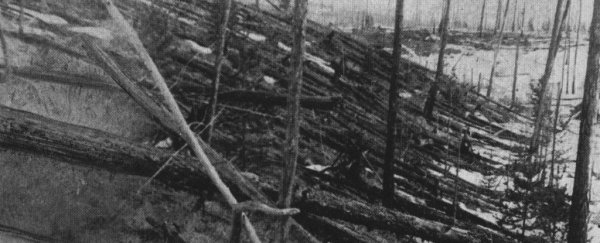In the early morning of 30 June 1908, something exploded over Siberia. The event shattered the normal stillness of the sparsely populated taiga, so powerful that it flattened an area of forest 2,150 square kilometres (830 square miles) in size - felling an estimated 80 million trees.
Eyewitness reports describe a brilliant ball of light, shattered windows and falling plaster, and a deafening detonation not far from the local river. The Tunguska event - as it came to be known - was later characterised as an exploding meteor, or bolide, up to 30 megatons, at an altitude of 10 to 15 kilometres (6.2 to 9.3 miles).
It is often referred to as the "largest impact event in recorded history", even though no impact crater was found. Later searches have turned up fragments of rock that could be meteoric in origin, but the event still has a looming question mark. Was it really a bolide? And if it wasn't, what could it be?
Well, it's possible we'll never actually know… but according to a recent peer-reviewed paper, a large iron asteroid entering Earth's atmosphere and skimming the planet at a relatively low altitude before flying back into space could have produced the effects of the Tunguska event by producing a shock wave that devastated the surface.
"We have studied the conditions of through passage of asteroids with diameters 200, 100, and 50 metres, consisting of three types of materials - iron, stone, and water ice, across the Earth's atmosphere with a minimum trajectory altitude in the range 10 to 15 kilometres," wrote researchers led by astronomer Daniil Khrennikov of the Siberian Federal University in their paper.
"The results obtained support our idea explaining one of the long-standing problems of astronomy - the Tunguska phenomenon, which has not received reasonable and comprehensive interpretations to date. We argue that the Tunguska event was caused by an iron asteroid body, which passed through the Earth's atmosphere and continued to the near-solar orbit."
The team mathematically modelled the passage of all three asteroid compositions at different sizes to determine whether such an event is possible.
The ice body - a hypothesis floated by Russian researchers in the 1970s - was pretty simple to rule out. The heat generated by the speed required to obtain the estimated trajectory would have entirely melted the ice body before it reached the distance observational data suggests it covered.
The rocky body, too, would be less likely to survive. Meteors are thought to explode when air enters the body through small fractures in the meteor, causing a build-up of pressure as it flies through the air at high speed. Iron bodies are much more resistant to fragmentation than rocky ones.
According to the team's calculations, the most likely culprit is an iron meteorite between 100 and 200 metres (320 to 650 feet) across that flew 3,000 kilometres (1,800 miles) through the atmosphere. It would never have dropped below 11.2 kilometres per second (7 mps), or below an altitude of 11 kilometres.
This model would explain several characteristics of the Tunguska event. The lack of an impact crater, for one, since the meteor would skim past the epicentre of the explosion without falling.
The lack of iron debris is also explained by this high velocity, since the object would be moving too fast, and would be too hot, to drop much. Any mass lost would be, the researchers said, through the sublimation of individual iron atoms, which would look exactly like normal terrestrial oxides.
"Within this version," the researchers also noted, "we can explain optical effects associated with a strong dustiness of high layers of the atmosphere over Europe, which caused a bright glow of the night sky."
While the results are certainly compelling, the researchers note their paper has some limitations they hope can be resolved with future research. For one, they "did not deal with the problem of the formation of a shockwave", although their initial comparisons to the Chelyabinsk meteorite allow for a huge shockwave to have plausibly occurred in Tunguska.
Nevertheless, the idea of an iron body pummelling through our atmosphere certainly is intriguing, and we can look forward to more papers on the subject.
The research has been published in the Monthly Notices of the Royal Astronomical Society.
